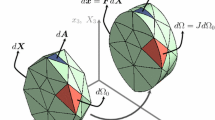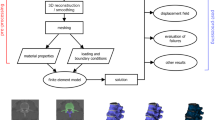Abstract
Elasticity parameters are central to physically-based animation and medical image analysis. We present an accelerated method to automatically estimate these parameters for a deformation simulator using an iterative optimization framework, given the desired (target) output surface/shape. During the optimization, the input model is deformed by the simulator, and the distance between the deformed surface and the target surface is minimized numerically. To accelerate the optimization process, we introduce a dimension reduction technique to allow a trade-off between the computational efficiency and desired accuracy. The reduced model is constructed using statistical training with a set of example deformations. To demonstrate this approach, we apply the computational framework to 2D animations of elastic bodies simulated with a linear finite element method. We also present a 3D elastography example, which is simulated with a reduced-dimension finite element model to improve the performance of the optimizer.








Similar content being viewed by others
References
Balay, S., Gropp, W.D., McInnes, L.C., Smith, B.F.: Efficient management of parallelism in object-oriented numerical software libraries. In: Modern Software Tools Scientific Computing, pp. 163–202 (1997)
Balocco, S., Camara, O., Frangi, A.F.: Towards regional elastography of intracranial aneurysms. In: Medical Image Computing and Computer-Assisted Intervention, vol. 11, pp. 131–138 (2008)
Barbič, J., da Silva, M., Popović, J.: Deformable object animation using reduced optimal control. ACM Trans. Graph. 28(3), 1 (2009). Proceedings of ACM SIGGRAPH 2009
Becker, M., Teschner, M.: Robust and efficient estimation of elasticity parameters using the linear finite element method. In: Proc. of Simulation and Visualization, pp. 15–28 (2007)
Bergou, M., Mathur, S., Wardetzky, M., Grinspun, E.: TRACKS: toward directable thin shells. In: ACM SIGGRAPH 2007 Papers, p. 50 (2007)
Bhat, K.S., Twigg, C.D., Hodgins, J.K., Khosla, P.K., Popovic, Z., Seitz, S.M.: Estimating cloth simulation parameters from video. In: Proceedings of the 2003 ACM SIGGRAPH/Eurographics Symposium on Computer Animation, pp. 37–51 (2003)
Bickel, B., Bächer, M., Otaduy, M.A., Lee, H.R., Pfister, H., Gross, M., Matusik, W.: Design and fabrication of materials with desired deformation behavior. In: ACM SIGGRAPH 2010 Papers, pp. 1–10 (2010)
Bickel, B., Bächer, M., Otaduy, M.A., Matusik, W., Pfister, H., Gross, M.: Capture and modeling of non-linear heterogeneous soft tissue. In: ACM SIGGRAPH 2009 Papers, pp. 1–9 (2009)
Cootes, T.F., Taylor, C.J., Cooper, D.H., Graham, J.: Active shape models—their training and application. Comput. Vis. Image Underst. 61(1), 38–59 (1995)
Fu, D., Levinson, S., Gracewski, S., Parker, K.: Non-invasive quantitative reconstruction of tissue elasticity using an iterative forward approach. Phys. Med. Biol. 45(6), 1495–1510 (2000)
Hensel, J.M., Menard, C., Chung, P.W.M., Milosevic, M.F., Kirilova, A., Moseley, J.L., Haider, M.A., Brock, K.K.: Development of multiorgan finite element-based prostate deformation model enabling registration of endorectal coil magnetic resonance imaging for radiotherapy planning. Int. J. Radiat. Oncol. Biol. Phys. 68(5), 1522–1528 (2007)
Igarashi, T., Moscovich, T., Hughes, J.F.: As-rigid-as-possible shape manipulation. ACM Trans. Graph. 24(3), 1134–1141 (2005)
Kallel, F., Bertrand, M.: Tissue elasticity reconstruction using linear perturbation method. IEEE Trans. Med. Imaging 15(3), 299–313 (1996)
Kaus, M.R., Brock, K.K., Pekar, V., Dawson, L.A., Nichol, A.M., Jaffray, D.A.: Assessment of a model-based deformable image registration approach for radiation therapy planning. Int. J. Radiat. Oncol. Biol. Phys. 68(2), 572–580 (2007)
Krysl, P., Lall, S., Marsden, J.E.: Dimensional model reduction in non-linear finite element dynamics of solids and structures. Int. J. Numer. Methods Eng. 51(4), 479–504 (2001)
Lee, H., Foskey, M., Niethammer, M., Lin, M.: Physically-based deformable image registration with material property and boundary condition estimation. In: Proceedings of the 2010 IEEE International Conference on Biomedical Imaging: from Nano to Macro, pp. 532–535 (2010)
Martin, S., Thomaszewski, B., Grinspun, E., Gross, M.: Example-based elastic materials. In: Proceedings of SIGGRAPH 2011, vol. 30, pp. 72:1–72:8 (2011)
McNamara, A., Treuille, A., Popović, Z., Stam, J.: Fluid control using the adjoint method. ACM Trans. Graph. 23(3), 449–456 (2004)
Müller, M., Gross, M.: Interactive virtual materials. In: Proceedings of Graphics Interface 2004, GI’04, pp. 239–246 (2004)
Muthupillai, R., Ehman, R.L.: Magnetic resonance elastography. Nat. Med. 2(5), 601–603 (1996)
Nealen, A., Muller, M., Keiser, R., Boxerman, E., Carlson, M.: Physically based deformable models in computer graphics. Comput. Graph. Forum 25, 809–836 (2006)
Nocedal, J., Wright, S.: Numerical Optimization. Springer, Berlin (1999)
Ophir, J., Alam, S., Garra, B., Kallel, F., Konofagou, E., Krouskop, T., Varghese, T.: Elastography: ultrasonic estimation and imaging of the elastic properties of tissues. Proc. Inst. Mech. Eng., H J. Eng. Med. 213(3), 203–233 (1999)
Pai, D.K., Doel, K.v.d., James, D.L., Lang, J., Lloyd, J.E., Richmond, J.L., Yau, S.H.: Scanning physical interaction behavior of 3D objects. In: Proceedings of SIGGRAPH 2001, SIGGRAPH ’01, pp. 87–96 (2001).
Pizer, S.M., Fletcher, P.T., Joshi, S., Thall, A., Chen, J.Z., Fridman, Y., Fritsch, D.S., Gash, A.G., Glotzer, J.M., Jiroutek, M.R., Lu, C., Muller, K.E., Tracton, G., Yushkevich, P., Chaney, E.L.: Deformable M-Reps for 3D medical image segmentation. Int. J. Comput. Vis. 55(2–3), 85–106 (2003)
Press, W.H.: Numerical Recipes. Cambridge University Press, Cambridge (2007)
Rivaz, H., Boctor, E., Foroughi, P., Zellars, R., Fichtinger, G., Hager, G.: Ultrasound elastography: a dynamic programming approach. IEEE Trans. Med. Imaging 27(10), 1373–1377 (2008)
Schnur, D.S., Zabaras, N.: An inverse method for determining elastic material properties and a material interface. Int. J. Numer. Methods Eng. 33(10), 2039–2057 (1992)
Shewchuk, J.R.: Triangle: Engineering a 2D quality mesh generator and Delaunay triangulator. In: Applied Computational Geometry Towards Geometric Engineering, vol. 1148, pp. 203–222. Springer, Berlin (1996)
Si, H.: TetGen: a quality tetrahedral mesh generator and three-dimensional Delaunay triangulator (2009). URL http://tetgen.berlios.de/
Skovoroda, A., Emelianov, S.: Tissue elasticity reconstruction based on ultrasonic displacement and strain images. IEEE Trans. Ultrason. Ferroelectr. Freq. Control 42(4), 141 (1995)
Syllebranque, C., Boivin, S.: Estimation of mechanical parameters of deformable solids from videos. Vis. Comput. 24(11), 963–972 (2008)
Taylor, Z.A., Crozier, S., Ourselin, S.: Real-time surgical simulation using reduced order finite element analysis. Med. Image Comput. Comput. Assist. Interv. 13(Pt 2), 388–395 (2010)
Teschner, M., Heidelberger, B., Manocha, D., Govindaraju, N., Zachmann, G., Kimmerle, S., Mezger, J., Fuhrmann, A.: Collision handling in dynamic simulation environments: the evolution of graphics: where to nex? In: Eurographics 2005 Tutorial (2005)
Treuille, A., McNamara, A., Popović, Z., Stam, J.: Keyframe control of smoke simulations. In: ACM SIGGRAPH 2003 Papers, pp. 716–723 (2003)
Washington, C.W., Miga, M.I.: Modality independent elastography (MIE): a new approach to elasticity imaging. IEEE Trans. Med. Image 23(9), 1117–1128 (2004)
Weng, Y., Xu, W., Wu, Y., Zhou, K., Guo, B.: 2D shape deformation using nonlinear least squares optimization. Vis. Comput. 22(9–11), 653–660 (2006)
Yang, W., Feng, J., Jin, X.: Shape deformation with tunable stiffness. Vis. Comput. 24(7–9), 495–503 (2008)
Yoo, T.S., Ackerman, M.J., Lorensen, W.E., Schroeder, W., Chalana, V., Aylward, S., Metaxas, D., Whitaker, R.: Engineering and algorithm design for an image processing API: a technical report on ITK—the insight toolkit (2002)
Yushkevich, P.A., Piven, J., Hazlett, H.C., Smith, R.G., Ho, S., Gee, J.C., Gerig, G.: User-guided 3D active contour segmentation of anatomical structures: significantly improved efficiency and reliability. NeuroImage 31(3), 1116–1128 (2006)
Zhu, Y., Hall, T., Jiang, J.: A finite-element approach for Young’s modulus reconstruction. IEEE Trans. Med. Imaging 22(7), 890–901 (2003)
Zienkiewicz, O.C., Taylor, R.L.: The Finite Element Method, 6th edn. Butterworth-Heinemann, Oxford (2005)
Acknowledgements
We thank Mark Foskey, Marc Niethammer, Ron Alterovitz, and Ed Chaney for helpful discussions. We also thank Zijie Xu and Dr. Ron Chen for providing prostate patient CT data. This work was partially supported by Army Research Office, National Science Foundation, and Carolina Development Foundation.
Author information
Authors and Affiliations
Corresponding author
Electronic Supplementary Material
Below is the link to the electronic supplementary material.
Rights and permissions
About this article
Cite this article
Lee, HP., Lin, M.C. Fast optimization-based elasticity parameter estimation using reduced models. Vis Comput 28, 553–562 (2012). https://doi.org/10.1007/s00371-012-0686-z
Published:
Issue Date:
DOI: https://doi.org/10.1007/s00371-012-0686-z




